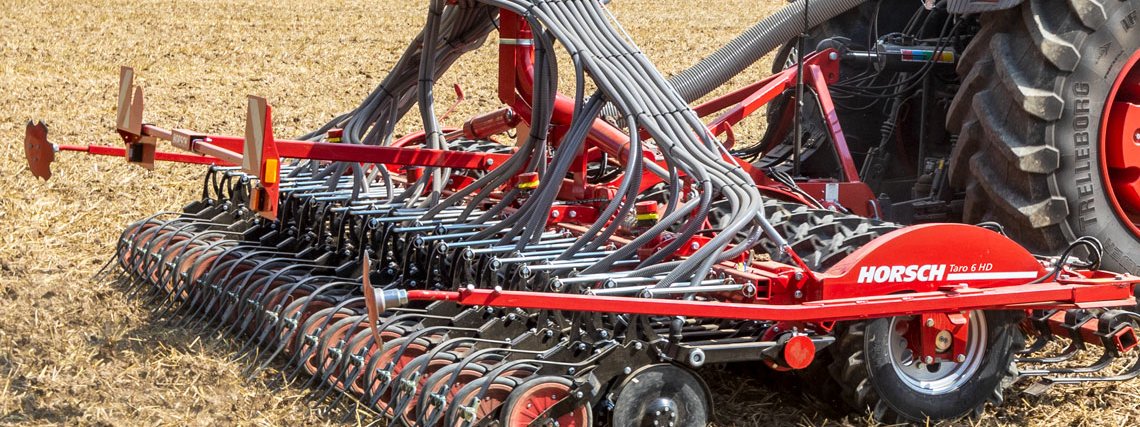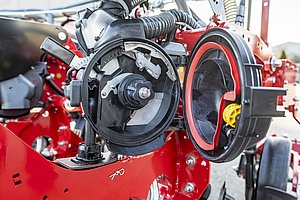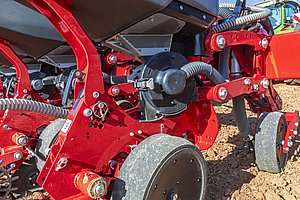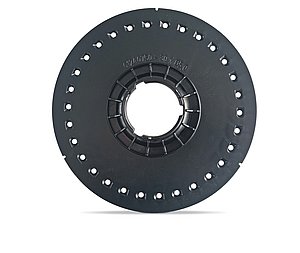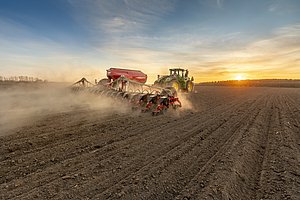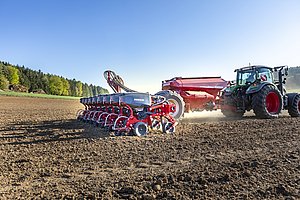Maestro metering units AirVac and AirSpeed
Now we want to talk about the other components of our new metering unit. Let’s start with the grain uptake: The grain feed slide controls how many grains get into the metering unit und thus, the supply of grains at the metering disc. The slide can also be used to separate the metering unit completely from the seed supply so that the seed box does not have to be emptied if for example the metering disc is changed. Moreover, the position of the feed slide influences the grain uptake behaviour and, thus, the singulation result. In general: For larger seeds like maize or beans the slide can be opened a little bit more, for smaller seeds like sugar beet or rape the slide can be closed a little bit further. The less seed is in the metering unit, the exacter is the grain uptake as the grain that is taken up at the metering disc hole does not have to be “pushed” through a large quantity of grains in the supply area. You have, of course, to make sure that there always is enough seed in the metering unit. So-called agitator pockets are integrated in the metering discs of our new metering unit generation. They constantly mix the seed depot and see to it that the grains in the supply area always move and cannot get stuck. Thus, you can prevent gaps already at the time of the grain uptake.
After the grain uptake possible double spots are eliminated by our singulator. The grains are then transported to the grain outlet of the metering units. The grains are ejected via the end section of the vacuum resp. overpressure area – to be specific via the seal that is integrated in the cover of the metering unit. The grains do no longer adhere to the holes of the metering disc and, with the AirVac system, fall directly to the ground through the fall tube. After that they are caught by the catching roller so that the grains cannot roll away and are embedded. With the shoot system AirSpeed the grains are caught by another air current immediately after the overpressure area has been sealed. They are shot into the soil with high speed through the shoot pipe, are caught and embedded. The transfer and the acceleration of the grain is carried out according to the Coanda effect. The grain is in the middle of the air current, is surrounded by the faster air and thus accelerated and transported. Due to this active, controlled transport an excellent longitudinal distribution of the plants in the population can be achieved even at operational speeds of up to 15 km/h. On the way to the ground the singulation accuracy in both systems is monitored by an optical grain counting sensor that is fixed at the fall tube resp. the shoot pipe. The sensor can detect gaps as well as double spots. Moreover, it can identify the distance between the grains and based on this information calculates the variation coefficient which is an indicator for the accuracy of the longitudinal distribution. The driver can see this information clearly on the terminal as an average value for the whole machine. It is also possible to have the determined value of an individual row displayed. If the tank is empty and no grains are sown, an optical and acoustic “Zero-grains-alarm“ is immediately displayed at the terminal.
After the grain outlet the last component used is a cleaning wheel in the cover of the metering unit. The star-shaped cleaning wheel pierces all holes of the metering disc and, if necessary, removes any broken grains that got jammed or cleans way any other dirt. This guarantees that all holes are clean, that grains can be taken up and gaps are prevented.
The metering units are driven by electric motors. The sowing density can be adjusted comfortably via the terminal. Changing to another type of crop also requires only little manual intervention. In addition to the adaption of the metering disc and, if necessary, of the cleaning wheel you only have to enter the correct type of crop at the terminal. The system then knows how many holes there are on the metering disc. Moreover, the parameters of the grain monitoring are tailored to the respective crop. Thus, functions like SectionControl and VariableRate are available as a standard. The machine only has to be operated via a terminal where these functions are activated. When using VariableRate, the function „VariableRate Row-by-Row“ is also available as a standard for all machines. You can sow differentiatedly according to the individual row and therefore use an application map with a resolution that corresponds to the row spacing. With the Maestro you can also operate irrigation lanes or freely configurable tramlines. If required, the sowing density in the neighbour rows of the lane is automatically increased by percentage.
These equipment options and our new metering unit generation AirVac and AirSpeed are available for all Maestros for sowing season 2021. We will soon inform you about the different types of the product family.
